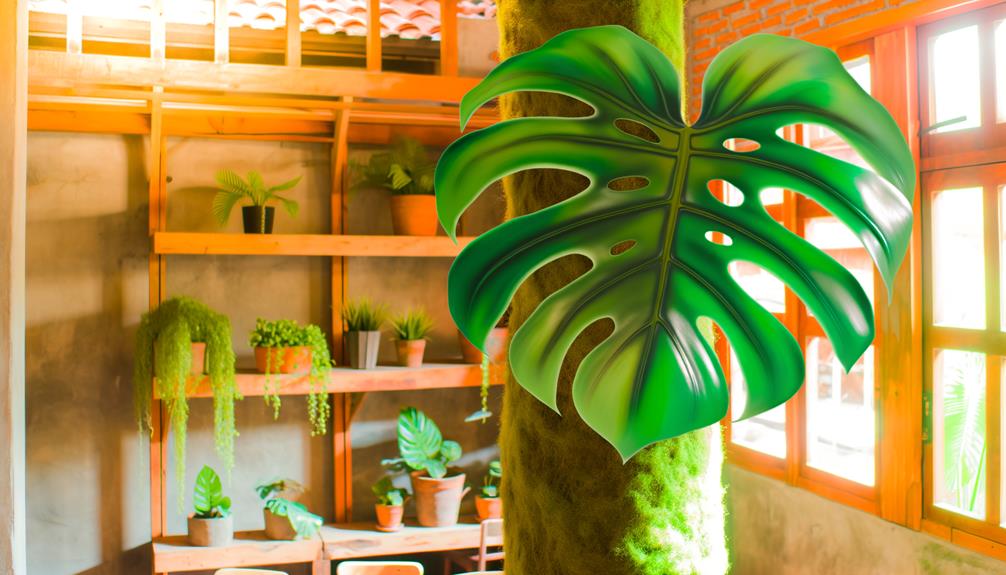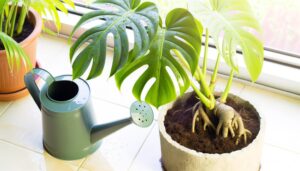Monstera Borsigiana Climbing Support Tips
To help your Monstera Borsigiana climb, choose a moss pole or trellis made from non-toxic, durable materials. Position the support close to the plant's base and anchor securely in soil.
Use soft plant ties to loosely fasten the vines every few inches, first securing main stems and then lateral branches. Prune during the growing season with sterilized shears to encourage new growth and remove dead foliage.
Regularly monitor the plant for stability, adjusting ties and supports as necessary. By following these technical guidelines, you'll ensure a robust and healthy climbing Monstera.
For more detailed care strategies, keep exploring.

Key Takeaways
- Use a moss pole to retain moisture and promote root adhesion.
- Secure support 1-2 inches from the plant's base for optimal growth.
- Fasten vines with soft ties, checking regularly to prevent constriction.
- Prune in the growing season, cutting above nodes to encourage new growth.
- Regularly monitor and adjust support to ensure stability and prevent plant stress.
Choosing the Right Support
When selecting the appropriate support for your Monstera borsigiana, make certain you choose a structure that mimics its natural climbing environment, such as a moss pole or trellis. These supports provide the aerial roots with a medium to attach, promoting healthier growth.
Moss poles, crafted from sphagnum moss, retain moisture, which promotes root adhesion. Trellises, typically made from wood or metal, offer a sturdy framework but may require additional ties to secure the plant.
Be certain that the support is tall enough to accommodate future growth, usually about twice the height of the plant. Using materials that are non-toxic and durable will prevent any adverse effects on the plant's health. This approach fosters robust, vertical growth, enhancing the Monstera's aesthetic appeal.
Positioning Your Support
Maximize growth potential for your Monstera borsigiana by positioning the support structure close to the plant's base, aligning it vertically to promote natural climbing behavior. Ensure the support is securely anchored in the soil to prevent tipping.
Position the support approximately 1-2 inches from the stem to allow the aerial roots to attach easily. Use a strong, moisture-retentive material like a moss pole or a coir pole, as these provide both stability and hydration.
Regularly check the alignment and stability of the support structure, making adjustments as the plant grows. This precise positioning fosters optimal attachment and climbing, enhancing the plant's overall well-being and growth efficiency.
Keep the surrounding environment humid to promote robust root development.
Tying and Securing Vines
Fasten the Monstera borsigiana vines to the support structure using soft plant ties or garden twine to prevent damage and guarantee proper attachment. It is crucial to tie the vines loosely to allow for growth and movement. Check the ties regularly to make sure they are not too tight, which could constrict the plant and hinder its development.
| Material | Benefits |
|---|---|
| Soft Plant Ties | Gentle on vines, reusable |
| Garden Twine | Biodegradable, easily adjustable |
| Velcro Straps | Adjustable, reusable |
| Plastic Clips | Quick to attach, reusable |
| Natural Raffia | Biodegradable, aesthetic appeal |
Position ties every few inches along the vine to encourage upward growth. Focus on securing the main stems first, then proceed to the lateral branches to guarantee overall stability.
Pruning for Better Growth
Pruning your Monstera borsigiana promotes healthier growth by removing dead or overcrowded foliage and redirecting energy to essential parts of the plant. This process requires precision. Use sterilized pruning shears to avoid introducing pathogens. Cut just above a node to encourage new growth. Regular pruning helps prevent diseases and pests, ensuring your plant thrives.
Key points to keep in mind:
- Timing: Prune during the growing season (spring and summer) for best recovery.
- Technique: Remove yellowing or damaged leaves first, then thin out dense areas.
- Tools: Always use clean, sharp tools to make clean cuts and minimize stress.
Monitoring and Adjusting
Consistently monitor your Monstera borsigiana to make certain it's receiving sufficient support and make adjustments as needed to promote ideal climbing growth.
Begin by inspecting the plant's attachment points to its support structure. Verify that the ties or clips holding the stems are secure, but not too tight to restrict growth. Look for signs of stress, such as wilting or discoloration, which may indicate inadequate support.
Observe the plant's climbing direction and adjust the support structure to guide growth vertically. If new aerial roots form, direct them toward the support.
Regularly check for any structural weaknesses or damage, replacing or reinforcing supports as needed.
Precision in these adjustments ensures robust, vertical growth and peak health for your Monstera borsigiana.
Conclusion
Think of your Monstera Borsigiana as a skilled rock climber, scaling its ascent with the right gear and guidance. By selecting a sturdy support, positioning it thoughtfully, securing the vines carefully, and pruning strategically, you're equipping your plant for a successful climb.
Just as a climber adjusts their route, regularly monitor and tweak the setup to ensure best growth. Your attentive care transforms the plant into a verdant conqueror, reaching new heights with each tendril.






